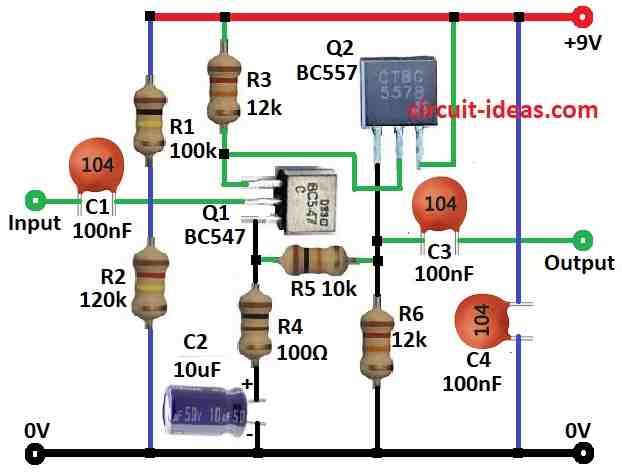Just imagine your voice is like a tiny whisper when it enters a microphone.
This microphone preamp circuit made with just two transistors, is like a small megaphone.
It boosts that whisper into a much stronger signal before it goes to the main amplifier making your voice loud and clear.
Circuit Working:

Parts List:
| Component Type | Description | Quantity |
|---|---|---|
| Resistors(All resistors are 1/4 watt unless specified) | 100k | 1 |
| 120k | 1 | |
| 100Ω | 1 | |
| 10k | 1 | |
| 12k | 2 | |
| Capacitors | Ceramic 100nF | 3 |
| Electrolytic 10µF 25V | 1 | |
| Semiconductors | Transistor BC547 | 1 |
| Transistor BC557 | 1 |
This circuit is a microphone preamplifier circuit that uses two bipolar junction transistors BJTs in a common emitter configuration.
The microphone is connected to the input of the circuit through capacitor C1.
C1 blocks any DC voltage from the microphone from reaching the base of Q1, a BC547 transistor and only allows the AC signal to pass through.
Resistor R1 100k sets the bias current for Q1.
Capacitor C2 10uF couples the amplified AC signal from Q1s collector to the next stage Q2s base while blocking any DC voltage from affecting Q2s operation.
Resistor R3 12k establishes the bias current for Q2 a BC557 transistor.
The microphones weak input signal is amplified by Q1.
This amplified signal is coupled to the base of Q2 through capacitor C2.
Resistor R5 10k in conjunction with R3 12k sets the overall gain of the circuit.
The voltage gain of this stage is approximately the ratio of R3 to R5 which is 12.
Capacitor C4 100nF blocks any DC voltage from reaching the output and couples only the amplified AC signal.
Overall, this is a simple and educational circuit that demonstrates the basics of building a microphone preamplifier with discrete transistors.
Formulas:
The following is a general formula for a preamplifier arrangement with two transistors used in a common emitter transistor amplifier circuit:
First Stage Transistor Q1 BC547
Voltage Gain (Av1) for Q1:
Av1 = −RC / RE
where,
- RC is collector resistor for transistor BC547
- RE emitter resistor for transistor BC547
Current Gain (Ai1) for Q1
Ai1 = β(RC / RE)
where,
- RC is collector resistor for transistor BC547
- RE emitter resistor for transistor BC547
- β represents the current gain of the transistor.
Second Stage Transistor Q2 BC557:
Voltage Gain (Av2) for Q2
Av2 = −RC2 / RE2
where,
- RC2 is collector resistor for transistor BC557
- RE2 is emitter resistor for transistor BC557
Current Gain (Ai2) for Q2
Ai2 = β(RC2 / RE2)
where,
- RC2 is collector resistor for transistor BC557
- RE2 is emitter resistor for transistor BC557
- β represents the current gain of the transistor.
Note:
Specific design needs, such as input impedance, voltage gain, bandwidth and noise performance, can be taken into account while modifying this fundamental formula and architecture.
How to Build:
To build a Simple Microphone Preamplifier Circuit using Two Transistors you need to follow the below mentioned steps for connections:
- Connect base of transistor BC547 Q1 to capacitor C1 100nF through input and resistor R1 100k to positive supply.
- Connect collector of transistor BC547 Q1 to resistor R3 12k and capacitor C2 10uF.
- Connect emitter of transistor BC547 Q1 to ground with resistor R4 100 ohm and C2 capacitor 10uF.
- Connect base of transistor BC557 Q2 between collector of transistor Q1 and resistor R3.
- Connect collector of transistor BC557 Q2 to ground.
- Connect emitter of transistor BC557 Q2 to positive supply.
- Connect capacitor C1 100nF between the input and the base of Q1 BC547.
- Connect capacitor C2 10uF to emitter of Q1 BC547 and the other end to ground.
- Connect capacitor C3 100nF to the emitter of Q2 and the other end to output.
- Connect capacitor C4 100uF between the output and ground.
- Connect series of two resistors R1 and R2 from positive supply to ground.
- Connect resistor R4 between R5 and R6 resistors.
Note:
- Please take care while handing the electrical items if possible seek the help of experts or any electrical assistance.
Conclusion:
A two transistor microphone preamplifier circuit offers a simple and educational way to boost weak microphone signals.
By utilizing two transistors in a common emitter configuration and controlling gain through resistors, this circuit provides a basic understanding of audio amplification principles.
Leave a Reply